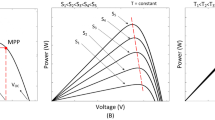Abstract
In this work, a standalone PV topology is modeled with different MPPT strategy. Total system consists of Photo-voltaic Array, MPPT Controller, and Buck Converters. For ensuring maximum output power, the most important component is the MPPT control strategy. For this action, many MPPT algorithms are used. The key aspect of the proposed system is to increase operational efficiency of the system. The PV system operates at optimum efficiency with the MPPT control phenomena. The dynamic behaviors of the system are investigated under different operating cases. The suggested system is modeled in MATLAB/SIMULINK platform for three different MPPT controller such as (i) P&O, (ii) Incremental conductance, and (iii) Fuzzy. This paper gives a comparative analysis of these three MPPT techniques for photo-voltaic systems.
Access this chapter
Tax calculation will be finalised at checkout
Purchases are for personal use only
Similar content being viewed by others
References
Miyatake M, Veerachary M, Toriumi F, Fujii N, Ko H (2011) Maximum power point tracking of multiple photovoltaic arrays: a PSO approach. IEEE Trans Aerosp Electron Syst 47:367–380
Tafticht T, Agbossou K, Doumbia M, Chériti A (2008) An improved maximum power point tracking method for photovoltaic systems. Renew Energy 33:1508–1516
Houssamo I, Locment F, Sechilariu M (2010) Maximum power tracking for photovoltaic power system: development and experimental comparison of two algorithms. Renew Energy 35:2381–2387
Priyadarshi N, Padmanaban S, Bhaskar MS, Blaabjerg F, Sharma A (2018) Fuzzy SVPWM-based inverter control realisation of grid integrated photovoltaic–wind system with fuzzy particle swarm optimization maximum power point tracking algorithm for a grid-connected PV/windpower generation system: hardware implementation. IET Elect Power Appl 12(7):962–971
Jedari M, Fathi SH (2017) A new approach for photovoltaic arraysmodeling and maximum power point estimation in real operating conditions. IEEE Trans Ind Electron 64(12):9334–9343
Aamri FE, Maker H, Sera D, Spataru SV, Guerrero JM, Mouhsen A (2018) A direct maximum power point tracking method for single phase grid-connected PV inverters. IEEE Trans Power Electron 33(10):8961–8971
Kumar N, Hussain I, Singh B, Panigrahi BK (2018) Framework of maximum power extraction from solar PV panel using self predictive perturb and observe algorithm. IEEE Trans Sustain Energy 9(2):895–903
Khan O, Acharya S, Hosani MA, Moursi MSE (2018) Hill climbingpower flow algorithm for hybrid DC/AC microgrids. IEEE Trans Power Electron 33(7):5532–5537
Raj A, Gupta M, Panda S (2016) Design simulation and performance assessment of yield and loss forecasting for 100 KWp grid connected solar PV system. In: 2016 2nd International conference on next generation computing technologies (NGCT). IEEE, pp 528–533
Pati N, Panda B (2020) Stability analysis of photovoltaic system under grid faults. Int J Power Electron Drive Syst (IJPEDS) 11(2):931–941
Sahu JK, Panda B, Sahu S Patra JP (2020) Harmonics estimation of a standalone PV system integrated with a modified SPWM inverter. In: 2020 3rd International conference on smart systems and inventive technology (ICSSIT). Tirunelveli, India, pp 654–656
Pradhan A, Panda B, Panda B, Khillo A (2020) An improved MPPT technique for in-creasing efficiency of PV module. In: Advances in electrical control and signal systems, pp 633–644
Author information
Authors and Affiliations
Corresponding author
Editor information
Editors and Affiliations
Rights and permissions
Copyright information
© 2023 The Author(s), under exclusive license to Springer Nature Singapore Pte Ltd.
About this paper
Cite this paper
Panda, B., Sharma, A., Nandi, S., Pradhan, A., Nanda, L., Samal, S. (2023). Modeling Solar Photo-Voltaic Power Generation System with MPPT Controller. In: Doriya, R., Soni, B., Shukla, A., Gao, XZ. (eds) Machine Learning, Image Processing, Network Security and Data Sciences. Lecture Notes in Electrical Engineering, vol 946. Springer, Singapore. https://doi.org/10.1007/978-981-19-5868-7_68
Download citation
DOI: https://doi.org/10.1007/978-981-19-5868-7_68
Published:
Publisher Name: Springer, Singapore
Print ISBN: 978-981-19-5867-0
Online ISBN: 978-981-19-5868-7
eBook Packages: Computer ScienceComputer Science (R0)




